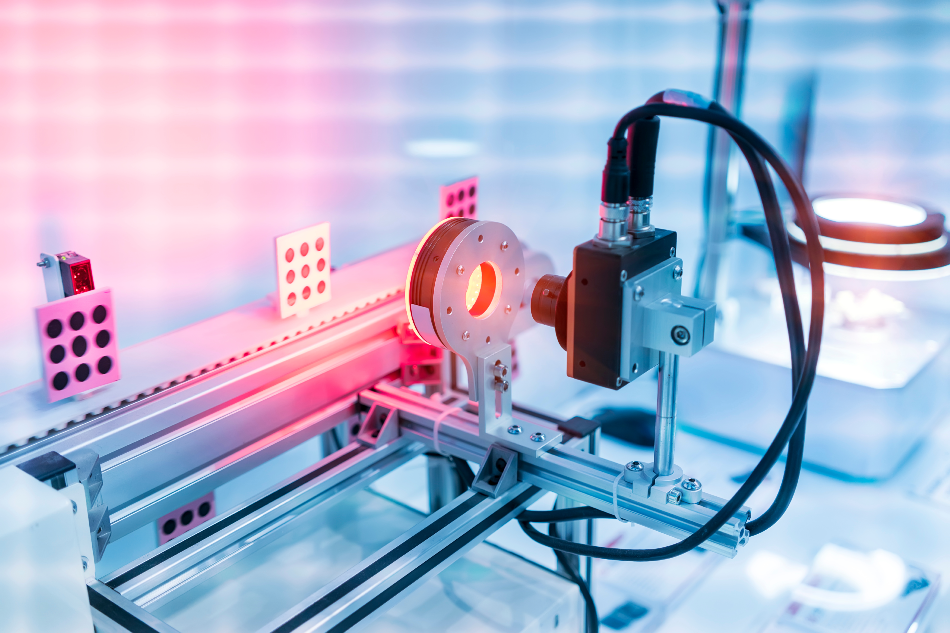How optical measurement system is reshaping automation workflows
The Value of an Optical Measurement System in Industrial Applications
Optical measurement systems play a crucial role in industrial applications. They offer high precision and promote non-contact measurement, which is crucial for safeguarding sensitive elements. These systems enhance operational efficiency and advertise quality assurance. Nonetheless, their execution is not without obstacles. Understanding their importance and the complexities included can illuminate their transformative potential in modern-day manufacturing. What are the specific advantages and challenges that these systems existing?
Understanding Optical Measurement Equipments
Optical measurement systems play a crucial role in numerous industrial applications by giving accurate and exact data collection. These systems make use of light to measure physical buildings such as dimensions, surface profiles, and material features. The fundamental parts generally consist of lasers, cameras, and sensing units that capture and evaluate light mirrored from items. By using methods such as interferometry and photogrammetry, these systems can discover minute adjustments fit and dimension, which are crucial for top quality control and product consistency.Furthermore, optical measurement systems are non-contact, permitting them to evaluate fragile or intricate products without creating damage. They are versatile, discovering applications in areas like aerospace, automobile, and electronics producing. The integration of sophisticated software application for data evaluation improves the performance of these systems, enabling real-time surveillance and feedback. As industries develop, the value of optical measurement systems proceeds to expand, supporting the need for greater accuracy and effectiveness.
Trick Advantages of Optical Measurement in Production
While conventional measurement techniques typically entail physical contact and can introduce mistakes, the adoption of optical measurement systems in making offers substantial advantages. These systems make use of non-contact techniques, minimizing the threat of damages to delicate elements and guaranteeing the stability of measurements. Optical measurement gives high precision and precision, allowing producers to accomplish limited resistances vital in competitive markets.Additionally, the rate of optical measurement systems boosts productivity. optical fibre diameter analyser. Fast information purchase permits real-time monitoring, facilitating prompt modifications in production procedures. This performance causes decreased waste and boosted resource allocation.Furthermore, the adaptability of optical systems accommodates a wide variety of materials and geometries, making them ideal for various applications. Their capacity to integrate effortlessly with automation technologies supports Market 4.0 campaigns, promoting smarter producing settings. Generally, the key advantages of optical measurement contribute substantially to improving quality assurance and functional efficiency in modern-day manufacturing setups
Applications of Optical Measurement Systems
Optical measurement systems play an important duty in numerous commercial applications, particularly in improving accuracy throughout making processes. They are important to quality assurance and guarantee, ensuring that products fulfill strict criteria. Additionally, these systems support study and development efforts by giving accurate data for technology and improvement.
Precision in Production Processes
In modern manufacturing, high precision is crucial for guaranteeing item top quality and operational effectiveness. Optical measurement systems offer advanced capabilities that considerably improve accuracy during the production procedure. These systems utilize light and imaging technologies to record thorough measurements of parts, allowing suppliers to attain limited tolerances and accurate dimensions. By integrating optical measurement into production operations, organizations can quickly determine variances from specs, thereby decreasing waste and decreasing rework. Moreover, the non-contact nature of optical measurements enables inspecting delicate or sensitive materials without risk of damages. Ultimately, the fostering of optical measurement systems fosters a society of precision in manufacturing, causing improved efficiency and competitiveness in the market.

Quality Control and Guarantee
Quality control in manufacturing greatly depends on exact measurement methods to ensure that products fulfill well-known requirements. Optical measurement systems play a critical role in this procedure, allowing accurate analyses of measurements, surface quality, and various other vital functions of made goods. By using high-resolution imaging and advanced evaluation algorithms, these systems spot inconsistencies from requirements, guaranteeing consistency throughout manufacturing. Additionally, optical dimensions can be non-destructive, preserving the honesty of products while promoting fast analyses. The combination of these systems right into high quality control methods boosts efficiency and decreases waste, inevitably adding to improved item reliability. As sectors endeavor for excellence, the fostering of optical measurement technologies ends up being increasingly vital for preserving affordable advantage and customer fulfillment.

Research Study and Growth Applications
As sectors undertaking for innovation, optical measurement systems have actually become an essential tool in r & d applications. fibre testing equipment. These innovative systems provide specific measurements of materials and components, enabling designers and scientists to obtain crucial understandings right into their residential properties and efficiency. Optical measurement innovations, such as laser scanning and interferometry, assist in the rapid prototyping of brand-new layouts and the optimization of existing items. By capturing high-resolution information, scientists can identify defects and examine the effect of different specifications on item functionality. In addition, these systems sustain interdisciplinary cooperation, connecting spaces between various disciplines. The assimilation of optical measurement systems right into R&D processes inevitably speeds up development timelines and cultivates the production of cutting-edge options in different commercial sectors
Contrasting Optical Measurement to Traditional Techniques
In contrasting optical measurement systems to traditional methods, a number of key variables emerge, consisting of precision and precision. Furthermore, the speed of measurement and cost-effectiveness play considerable roles in establishing the viability of each approach for commercial applications. This assessment highlights just how improvements in optical technology might use advantages over standard techniques.
Accuracy and Accuracy
Optical measurement systems offer substantial benefits in accuracy and precision contrasted to traditional measurement methods. These systems use innovative technology, such as lasers and high-resolution cams, to capture dimensional data with very little mistake. In contrast, typical methods commonly count on mechanical tools that can introduce variability because of human error or product wear. Optical systems can attain micrometer-level accuracy, ensuring constant outcomes even in intricate geometries. Additionally, they give non-contact measurement, minimizing the threat of damaging sensitive components. This capability is specifically useful in industries where resistances are critical, such as aerospace and vehicle production. The adoption of optical measurement modern technology boosts quality control and reduces the possibility of defects, inevitably boosting total manufacturing efficiency.
Speed of Measurement
The advantages of optical measurement systems prolong beyond precision and accuracy to consist of substantial renovations in measurement speed. Conventional measurement methods usually need lengthy configurations and hand-operated estimations, which can reduce manufacturing procedures. On the other hand, optical systems utilize advanced innovations such as laser scanning and imaging, making it possible for rapid information acquisition and processing. This effectiveness allows for real-time measurements, promoting quicker decision-making in manufacturing environments. The capability to capture big quantities of data in a brief time improves throughput and productivity, additional resources giving services an one-upmanship. In addition, with look at here reduced measurement times, optical systems lessen downtime related to assessments, better improving procedures. Subsequently, the speed of measurement in optical systems significantly adds to overall functional performance in industrial applications.
Cost-Effectiveness Evaluation
A detailed cost-effectiveness evaluation exposes that optical measurement systems often give significant economic benefits over traditional techniques. These systems commonly reduce the requirement for considerable physical configurations, decreasing labor expenses and downtime during measurement procedures. Optical approaches can also yield faster results, bring about increased efficiency and lowered operational expenses. In addition, the accuracy offered by optical measurements lowers the chance of costly errors, which can develop from manual interventions and standard methods. In the future, the initial investment in optical innovation is usually offset by cost savings in sources, time, and improved product top quality. Consequently, markets that take on optical measurement systems might discover themselves not just enhancing performance look at here but likewise attaining a much more desirable cost-benefit ratio compared to traditional methods.

The Function of Automation in Optical Measurement
While many markets increasingly count on precision and performance, automation has become a vital part in improving optical measurement processes. By integrating automated systems, companies can significantly boost measurement accuracy and decrease human mistake. Automated optical measurement systems make use of advanced algorithms and sensors to supply real-time data analysis, assisting in quicker decision-making and procedure adjustments.Additionally, automation permits consistent measurements across different manufacturing runs, making certain that quality standards are maintained. The scalability of automated optical measurement systems makes them appropriate for varied applications, from quality assurance in manufacturing to examination in semiconductor production.Furthermore, these systems can be perfectly integrated into existing production configurations, advertising a smooth change towards more effective operations. In general, the function of automation in optical measurement is crucial, offering improved integrity, decreased labor prices, and enhanced functional efficiency, eventually driving commercial competition.
Obstacles and Considerations in Execution
Implementing optical measurement systems, despite the benefits of automation, presents different challenges and considerations that organizations need to browse. One considerable difficulty is the combination of these systems into existing process, which might require significant adjustments in procedures and worker training. Organizations needs to likewise attend to the compatibility of optical measurement innovations with present devices and software.Additionally, the variability of materials and ecological conditions can impact measurement precision, demanding durable calibration and maintenance methods. Price is an additional important consideration, as initial investments can be significant, and companies should weigh these costs versus possible efficiency gains. Information administration additionally poses obstacles, as the volume of info generated needs efficient systems for storage, analysis, and analysis. Making sure compliance with sector requirements and regulations includes another layer of intricacy to the implementation procedure, needing careful preparation and implementation.
Future Trends in Optical Measurement Technology
As markets remain to progress, advancements in optical measurement modern technology are set to transform their functional landscapes. Arising trends suggest a change in the direction of increased automation and assimilation with synthetic knowledge, boosting the precision and effectiveness of dimensions. Adaptive optics is acquiring grip, enabling systems to readjust in real-time to differing environmental conditions, therefore minimizing errors. Moreover, the miniaturization of optical sensors is allowing their release in much more small and varied setups, expanding application opportunities in fields such as aerospace and manufacturing.Additionally, the development of 3D optical measurement techniques is reinventing quality control processes, supplying even more extensive data analysis. Developments in data processing formulas are likewise expected to improve the interpretation of complex dimensions, making understandings more accessible. Collectively, these fads mirror a future where optical measurement modern technology not only boosts precision however likewise enhances operational dexterity, placing markets to better meet evolving needs.
Often Asked Concerns
Just How Do Optical Measurement Systems Ensure Information Precision?
Optical measurement systems guarantee information accuracy through specific calibration, progressed algorithms, and high-resolution imaging. These parts function together to reduce errors, improve measurement consistency, and give dependable outcomes essential for numerous industrial applications and procedures.
What Is the Normal Life Expectancy of an Optical Measurement System?
The typical life expectancy of an optical measurement system differs, usually ranging from five to fifteen years. Variables influencing longevity consist of usage intensity, environmental conditions, upkeep methods, and technical advancements that may require upgrades or substitutes.
Can Optical Measurement Systems Be Customized for Certain Industries?

What Training Is Needed for Operating Optical Measurement Solutions?
Training for running optical measurement systems normally consists of understanding system components, software application usage, calibration techniques, information evaluation, and security protocols. Individuals usually take part in hands-on technique and might complete certification courses to enhance their effectiveness.
Exactly How Do Ecological Elements Affect Optical Measurement Outcomes?
Environmental variables, such as temperature level, humidity, and lighting problems, significantly affect optical measurement outcomes. Variations in these components can cause inaccuracies, influencing the precision and reliability of dimensions taken by optical systems in various setups.